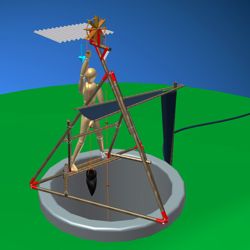|
Why
Fetching water by hand from an open well, more so from deep wells, with a rope and a bag or bucket is very tiresome when larger quantities are needed for irrigation. A small plot in Guatemala of the size of 1 querda (25m x 23m) needs every two days 230 to 380 liters. This work is normally done in an akward position, bending over the well, to make sure the bucket fills up and then hoisting in the often thin rope that cuts into the skin of hand. Without an appropriate way of water fetching the farmer is limited in the area that can be watered and therefore the income the farmer can get from his plot.
How
Important aspects of the IrrigationTripod are:
Rough sticks of only 5 cm thickness can be used. Wood is scarce where water is scarce and as little as possible should be needed.
For that reason they are interconnected with metal wire attached to metal strips nailed to the ends of the sticks. This interconnection is crucial for savety. Nobody should tamper with the quality of this connection, to prevent death and misery when a rig would collaps because of this connection being done in the wrong way.
There is a stick attached to the frame to stabilize your body against by leaning against it with your upper legs.
It is made esey to make the pulley run at exactly the right place
How the pulley is made is explained here.
|
|






